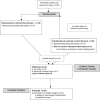Barriers and Facilitators to Lifestyle Intervention Engagement and Weight Loss in People Living With Spinal Cord Injury
- PMID: 33814891
- PMCID: PMC7983639
- DOI: 10.46292/sci20-00025
Barriers and Facilitators to Lifestyle Intervention Engagement and Weight Loss in People Living With Spinal Cord Injury
Abstract
Background: Individuals living with spinal cord injury (SCI) have a high prevalence of obesity and unique barriers to healthy lifestyle. Objective: To examine barriers and facilitators to engagement and weight loss among SCI participants enrolled in the Group Lifestyle Balance Adapted for individuals with Impaired Mobility (GLB-AIM), a 12-month intensive lifestyle intervention. Methods: SCI participants (N = 31) enrolled in a wait-list, randomized controlled trial where all participants received intervention between August 2015 and February 2017. Analyses of pooled data occurred in 2020 to examine cross-sectional and prospective associations of hypothesized barriers and facilitators with (1) intervention engagement, comprised of attendance and self-monitoring, and (2) percent weight change from baseline to 12 months. We performed multivariable linear regression on variables associated with outcomes at p < .05 in bivariate analyses and controlled for intervention group. Results: Participants were middle-aged (mean age, 48.26 ± 11.01 years), equally male (50%) and female, White (80.7%), and unemployed (65.6%). In participants who completed baseline surveys (n = 30), dietary self-efficacy explained 26% of variance in engagement (p < .01); among the 12-month study completers (n = 22, 71.0%), relationship issues explained 23% of variance in engagement (p < .01). Money problems, health issues unrelated to SCI, lack of motivation, and experimental group explained 57% of variance in weight loss (p for model < .01), with lack of motivation uniquely explaining 24% of variance (p < .01). Conclusion: Improving engagement and weight loss for persons with SCI in the GLBAIM program may be achieved by addressing lack of motivation, relationship issues, and nutrition self-efficacy.
Keywords: barriers; facilitators; intervention; obesity; spinal cord injury; weight loss.
© 2021 American Spinal Injury Association.
Conflict of interest statement
Conflicts of Interest The authors report no conflicts of interest.
References
-
- Weaver FM, Collins EG, Kurichi J et al. Prevalence of obesity and high blood pressure in veterans with spinal cord injuries and disorders. Am J Phys Med Rehabil. 2007;86(1):22–29. - PubMed
-
- Gupta N, White KT, Sandford PR. Body mass index in spinal cord injury – a retrospective study. Spinal Cord. 2006;44:92–94. - PubMed
-
- Johnston MV, Diab ME, Chu BC, Kirshblum S. Preventive services and health behaviors among people with spinal cord injury. J Spinal Cord Med. 2005;28(1):43–54. - PubMed
-
- Wen H, Chen Y, He Y, Bickel CS, Robinson-Whelen S, Heinemann AW. Racial differences in weight gain: a 5-year longitudinal study of persons with spinal cord injury. Arch Phys Med Rehabil. 2018;99(10):1957–1964. - PubMed
Publication types
MeSH terms
Grants and funding
LinkOut - more resources
Full Text Sources
Other Literature Sources
Medical

